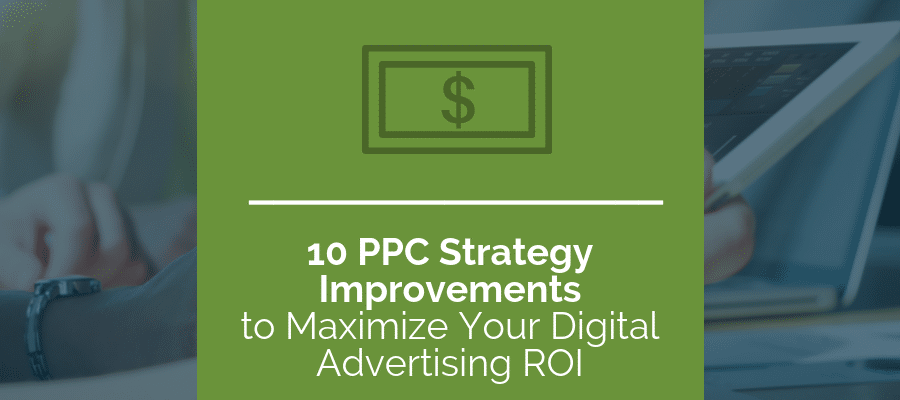
Digital advertising plays an important role in your overall digital marketing strategy, and your pay per click (PPC) strategy can make or break your digital ads. The ability to pay per click—or impression, conversion, or acquisition—in digital ads is one of its biggest advantages compared to traditional advertising. Your PPC strategy can help to put your advertisements in front of the best audience, the highest number of times, for the lowest cost.
PPC Strategies to Optimize Your Digital Marketing Campaign
Choose the Right Ad Platform
Where you focus your PPC strategy is the first thing to consider. Some platforms will be more effective than others. Facebook, Google Ads (formerly Adwords), Twitter, Taboola and many other popular social media, search, and display ad networks utilize PPC strategies. The algorithms determining ad placements and costs are different, however. The audience and function of each platform also differs.
1. Choose a PPC Platform For Your Audience
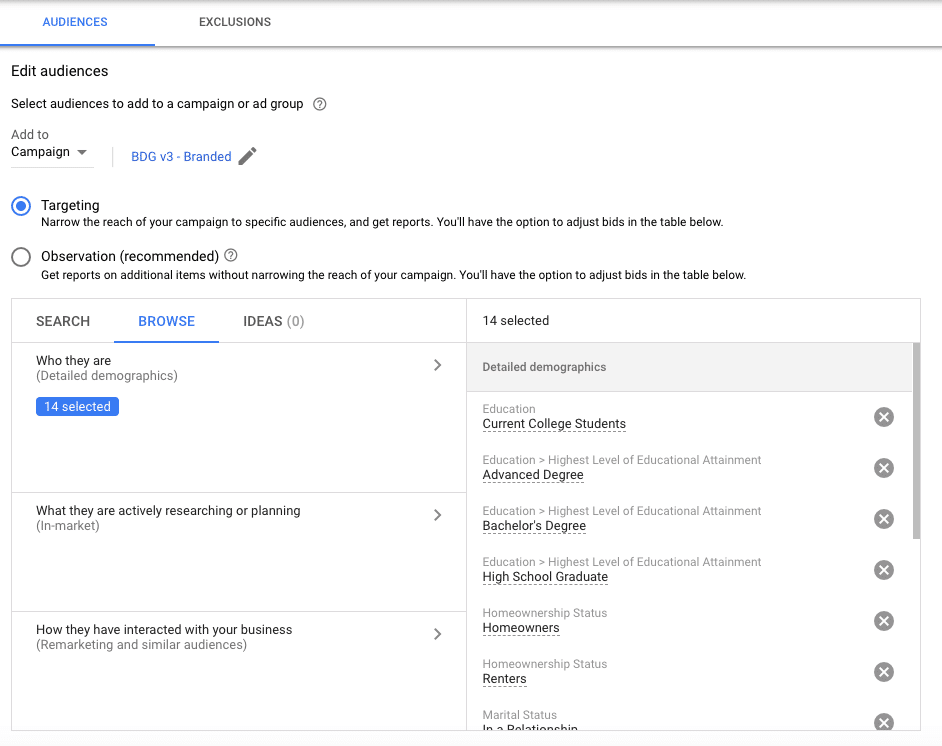
Narrow audience targeting in Google Ads, like Facebook Ads, can help you reach your target market on a vast platform.
Let’s consider two popular PPC social media advertising platforms; Facebook Ads and Instagram Ads. Though Facebook owns Instagram, the two platforms cater to different audiences. Facebook is the most-used social media platform in the world, and appeals to diverse groups of users. By contrast, 70% of Instagram’s user base is under 35 years old. Since Facebook serves a much wider demographic compared to Instagram, narrow targeting will be particularly important, to ensure you’re not wasting ad dollars on demographics unlikely to be interested in your ads. Instagram may be more effective specifically for younger markets, and give you more specific targeting options for them.
Simplify Your PPC Strategy
Get the Ultimate Guide to PPC Advertising »
2. Consider the PPC Platform’s Use and Function
It is also important to consider how users interact with each platform. If you want to interact with your prospective customer during an information search, it makes the most sense to use Google Ads. Or, If you want to reach your customer on a passive level—while they’re browsing the internet or having some downtime—Facebook or Instagram may make more sense. If you want to reach customers while they’re reading and posting content about their industry specifically, LinkedIn may be best. We’ll discuss PPC strategy and how it connects to the buyer’s journey and the platform’s purpose later in this post as well.
Don’t Set it and Forget it
The best digital advertising platforms “learn” as your ads run—the platform’s algorithms will automatically begin to show your ads to the most relevant users. While this is an important part of what makes digital ads effective, these algorithms need supervision. To make your PPC strategy effective, you should be checking in regularly and making changes. Here are a few things to look for as you do.
3. Improve Ad Quality
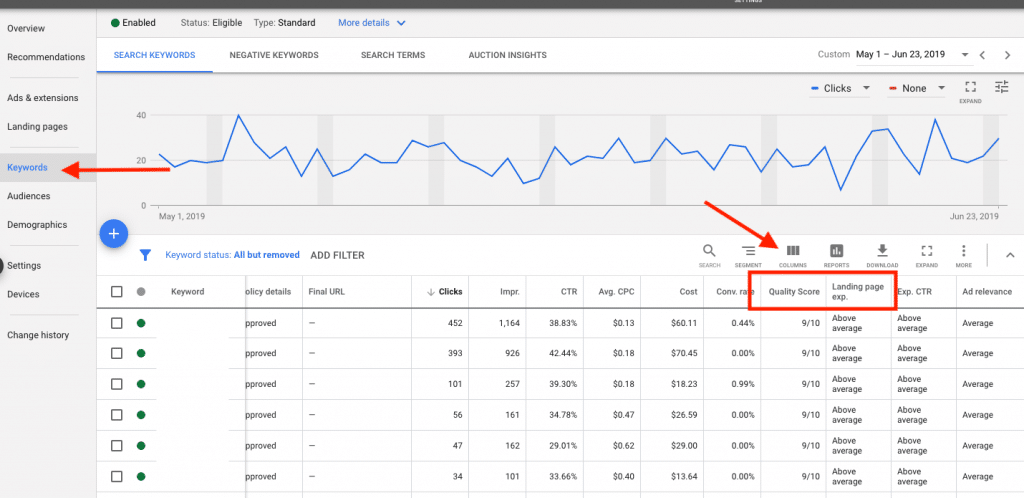
Quality score is an important consideration in Google Ads.
Do your advertisement, landing page, and search terms make sense together? Your ad quality score can tell you. In Google Ads, you’ll find this under the Keywords section of any ad campaign. You may need to add a Quality Score subsection to the view, which you can add using the column button appearing between the graph and the grid. Since Google wants to show users the best possible ads to create the best experience, ads with higher quality scores will pay less and win more placements.
4. Check Search Terms
Consider the search phrase “buy glasses near me.” Are you referring to eyeglasses or drinking glasses? Google will attempt to show ads when users search relevant terms, but the search engine doesn’t always recognize what’s relevant. It might, for example, correctly show your eyeglasses advertisement to users searching “sunglasses,” “eyeglasses,” and “reading glasses,” but might also show it to users searching “decorative glasses” or “wine glasses.” To prevent this, check in on your search terms regularly, which you’ll find in the Keywords section in Google Ads. Add negative keywords to make sure your ads aren’t wasted on irrelevant searches.
5. Adjust PPC Strategy by Cost

Check your bidding strategy regularly to optimize performance.
Google and other platforms will adjust the cost of your ad placement based on a number of different factors. You can keep from going over budget by setting a maximum bid, a maximum budget, or maximum daily spend. However, this will put constraints on your ad and prevent it from being shown to the maximum number of ideal users. It’s important to find a balance between cost and appearances using your own numbers, like average or lifetime customer value and digital marketing ROI goals. Make sure your cost per click and cost per conversion number make sense with this.
Map Ads to Sales Funnel Stages
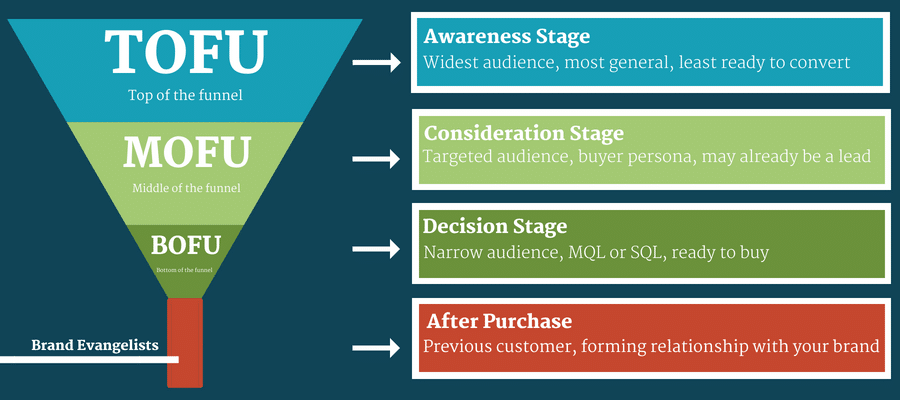
6. Use Social and Display Ads for Awareness Stage
At the awareness stage, the buyer is aware of a problem or need, but not yet sure how to solve it. Passive ads, such as social media and display ads, and search ads can be effective here, depending on your product or service. PPC strategy at this stage should use targeting, ad copy, and a landing page focused on exploring the problem, not necessarily your solution. When measuring conversions and costs, remember that sales are not the immediate goal at this stage.
7. Use Solution-Oriented Keywords in the Consideration Stage
In the consideration stage, the buyer understands the problem and is looking for solutions. Search ads and organic search are ideal here, as this is typically a research-heavy stage. The landing page should be information-oriented, supplying more information about potential solutions, but not necessarily branded solutions. Less competitive, more affordable keywords may focus on solution-oriented phrases, like “how do I…” or “alternatives to…”.
8. Be Specific in the Decision Stage
In the decision stage, the buyer has chosen a solution, and now needs a specific product or service. These types of search ads are often the most competitive, and therefore the most expensive. Specific targeting is an ideal PPC strategy at this stage for businesses looking to optimize conversions, as general keywords are more competitive, therefore demanding higher bids to appear. Highlight specific benefits or styles a customer might hone in on. For example, instead of “athletic shoes,” which would attract many clicks, but cost more and provide fewer conversions, a better term might be “blue high-performance running shoes.”
Optimize for Device
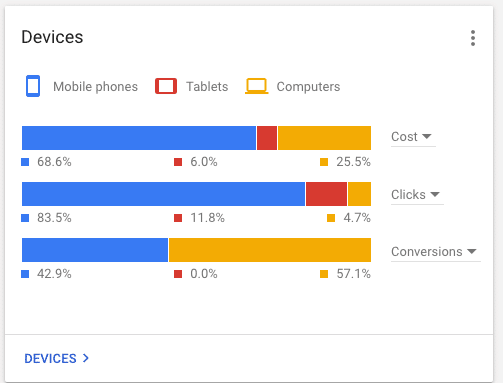
Knowing what devices your customers are using will help you optimize your PPC strategy.
More searches are now made on mobile devices than desktops or tablets, but these numbers vary by industry. To optimize your PPC strategy, you need to know how your customers are search as well as what they’re looking for. The Devices section of your Google Ads dashboard will tell you, overall or by each campaign, how your customers are searching.
9. Always Use Responsive Landing Pages
Responsive web design is a critical part of every website, but this is especially important for your ads and landing pages. If customers primarily search and click your ad on their phone, then they go to a landing page that is not mobile-friendly, your targeted PPC strategy is wasted. Make sure your mobile-friendly design extends to all parts of the page and your site, including text, pictures and design as well as functional elements like forms and buttons.
10. Combine Responsive Display Ads and Custom Display Ads
The wide variety of different screens and website configurations has created many different ad sizes. To fit your ad into the right place at the right time, Google can automatically reconfigure your ad to ensure it is sized and placed correctly. However, these do not always appear correctly. To fit into as many areas as possible without creating dozens of different versions of your ad, it’s ideal to use a combination of responsive and custom designs for your display ads. Use responsive ads, where Google automatically resizes text and pictures, on the less commonly-used formats. Make custom ads for the most common formats.
Optimizing your PPC strategy is a complex and ongoing process. Your PPC strategy will also depend on your business, budget and target market, so there is no one-size-fits all. Consider your goals carefully as you strategize, and reassess your position regularly so you can improve. If you’ve invested in PPC advertising, but you haven’t seen results, consider working with experts in digital marketing to get started right.
